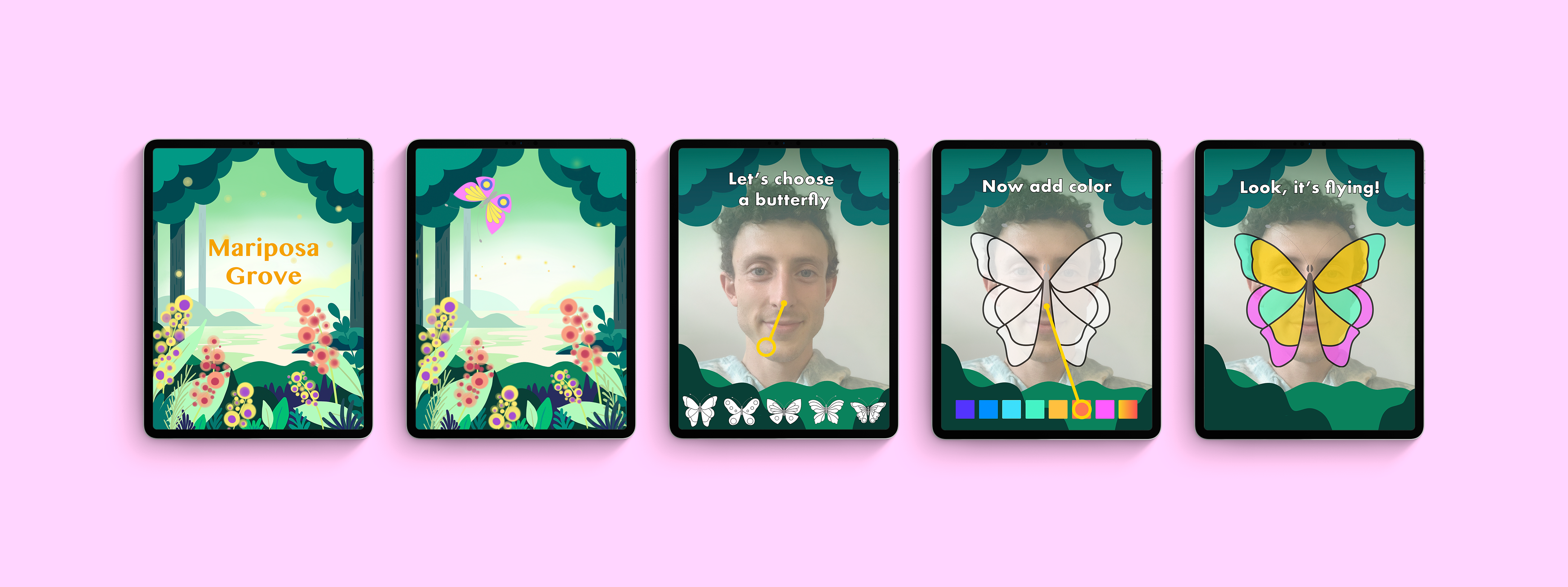Year: 2021
Role: Concept and Product Design, UX & UI research
Client: Studio Elsewhere for Lazarus Children’s Abilities Center
Media: Digital App using custom built library & paper.js
Team: David Azar (Software Engineering), Tim Fain (Music), Torin Blankensmith (Unreal Engine Interaction Integration),
Mariposa Grove is an inclusive drawing application designed specifically for children with cerebral palsy who work with the specialists at Charles Lazarus Children's Abilities Center. The app serves as a bridge between digital creativity and physical rehabilitation, allowing children of varying abilities to create personalized butterflies that come to life in the center's immersive projected environments.

App's main pages
Creating an engaging digital experience for children aged 3-18 with diverse motor abilities presented multiple design challenges. We needed to design for universal accessibility while maintaining appeal across a wide developmental range, create joy and agency within a clinical environment that can feel overwhelming, and seamlessly connect digital creation with physical environmental experiences.
Through extensive interviews, observations, and play-testing sessions with children and their families, we uncovered a crucial insight that became the foundation for our interaction paradigm: regardless of the severity of their condition, every child maintains control over their neck muscles. Our research revealed that traditional touch-based interfaces excluded many children with limited hand mobility, while children showed strong emotional attachment to their creative outputs when given true agency. We also discovered that the transition between digital and physical spaces needed clear visual and auditory cues, and that sophisticated visuals appealed universally across age groups despite varying preferences.
We developed an intuitive nose-pointer interaction system that transforms the front-facing iPad camera into an accessibility tool. Children use head movements to select butterfly templates from a curated collection, choose colors from an organized palette, apply colors with precision and control, and release their creation into the projected world. The app features multiple butterfly silhouettes with varying complexity levels, a sophisticated color palette with rich vibrant colors that appeal to both younger and older children, and progressive complexity with simple fill tools for beginners and detailed pattern options for advanced users. Every interaction provides immediate visual and audio feedback.
Once completed, butterflies transition from the iPad screen through an animated portal, accompanied by an original musical composition by Tim Fain. The butterflies then inhabit the projected forest environment, creating continuity throughout the child's medical visit and establishing emotional connections that extend beyond single appointments.
The technical implementation centers on real-time nose tracking using the device's front camera, with an adaptive interface that scales complexity based on user interaction patterns. The app maintains real-time communication with the projection system for seamless cross-platform synchronization, while offline capability ensures functionality regardless of network connectivity in medical settings.

Early stage prototypes and proof of concept
This project demonstrates the application of inclusive design principles, prioritizing accessibility from concept to execution through user-centered research conducted with users in real clinical contexts. The emotional design approach creates meaningful connections through personalized digital companions, while the cross-modal experience seamlessly bridges digital creation with physical environmental interaction.
Mariposa Grove established a foundation for expanded therapeutic gaming experiences, with plans to allow butterfly companions to travel throughout the medical center and extend into at-home care applications, positioning it as a scalable solution for pediatric rehabilitation environments.